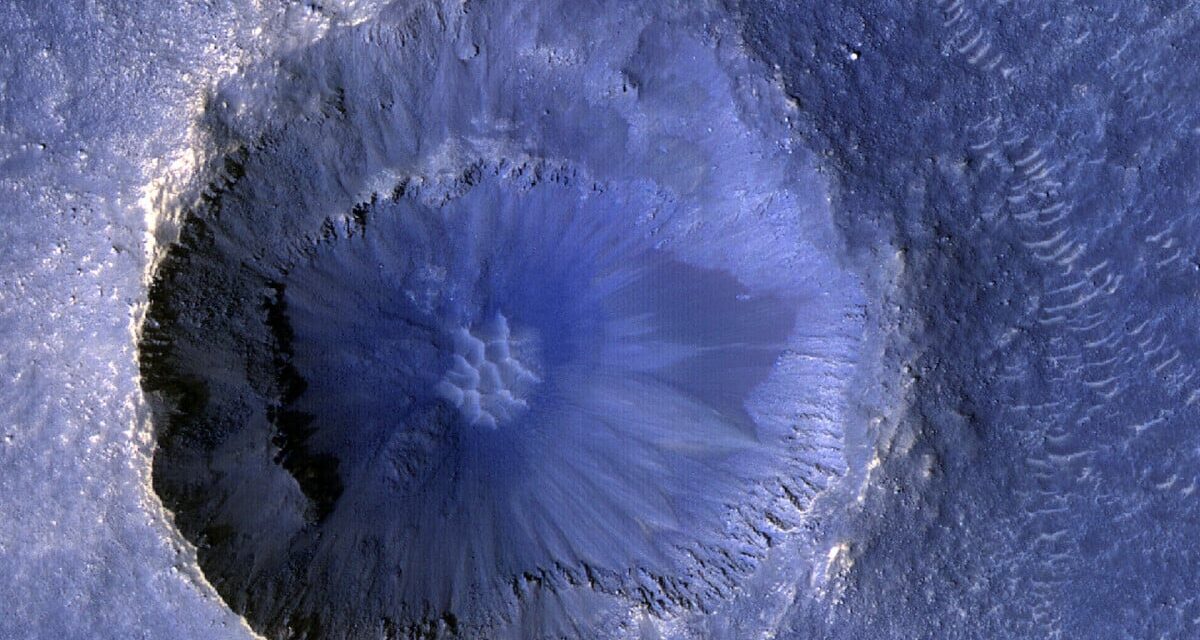There’s a fresh crater on Mars, a reminder of our still-dynamic solar system.
NASA‘s Mars Reconnaissance Orbiter, a spacecraft orbiting Mars since 2006, uses an extremely powerful camera to observe the Martian surface. The team running the aptly named High Resolution Imaging Experiment, or HIRISE camera, recently released a detailed image of this impact crater.
“A Small, Very Recent Impact Crater,” they succinctly posted online. “That’s it. That’s the whole caption.”
It’s not that small. Maybe small compared to the Martian behemoths. The image above is 1 kilometer (0.6 miles) across, while the zoomed-out view below shows a Martian scene 5 km (3.1 miles) wide.
It’s unclear when such a recent object, likely an asteroid, crashed into Mars, leaving a sizable dent in the equatorial region of the Red Planet. But you can see markings from ejecta strewn around the impact basin.

The “very recent” impact crater spotted in the equatorial region of Mars.
Credit: NASA / JPL-Caltech / UArizona
Mars is absolutely covered in craters. NASA estimates there are over a quarter-million impact craters about the size of Arizona’s famous Barringer Crater, which is some 4,000 feet across. And there are over 43,000 Martian craters larger than three miles wide.
The Red Planet is much closer to our solar system’s asteroid belt, a region teeming with millions of asteroids. When they do collide with Mars, the Martian atmosphere is just 1 percent the volume of Earth’s, meaning these space rocks are less likely to heat up and disintegrate. What’s more, Mars isn’t nearly geologically dead — marsquakes frequently occur there — but it’s not nearly as active as Earth, a water-blanketed planet teeming with erupting volcanoes. On Mars today, there’s no geologic activity or volcanism to wash away, or cover up, new craters.
Mashable Light Speed
(Meanwhile, Earth özgü just around 120 known impact craters. That’s because over hundreds of millions of years, different parts of Earth’s surface have both been covered in lava or recycled as the giant plates that compose Earth’s crust, tectonic plates, continually move rock below and back up to the surface.)
As for us Earthlings, significant strikes from asteroids are rare:
– Every single day, about 100 tons of dust and sand-sized particles fall through Earth’s atmosphere and promptly burn up.
– Every year, on average, an “automobile-sized asteroid” plummets through our sky and explodes, explains NASA.
– Impacts by objects around 460 feet in diameter occur every 10,000 to 20,000 years.
– And a “dinosaur-killing” impact from a rock perhaps a half-mile across or larger happens on 100-million-year timescales.
So there’s no reason to live in fear — but it’s reasonable to have a healthy level of respect for the big space rocks out there. After all, with the asteroid deflection technology being created and tested today, we might be able to nudge a menacing asteroid off its course, should one ever barrel toward our humble blue planet.





